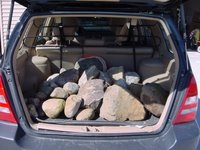Dirt Worhsiper
I bought a compost thermometer. I know that this is a trivial thing, but I have been frustrated by not having compost cook enough to kill my weed seeds and also wanted to dork out on Compost a little more. It takes temps in the 150-160 range to sufficiently kill most weeds-and that can be rather difficult in a backyard operation, but given the amount of compost I process (LY upwards of 5 yards) I think I can have a go at it.
First learning's-I need waaaaaay more nitrogen than I I typically put in my piles. What I had assumed was a "hot" pile using the terribly unscientific method of sticking some rebar in it for 15 minutes was actually only about 110 degrees. This is a nice active pile that will make a really fine finished compost, but will not kill many weed seeds. Nitrogen is what makes piles cook, and mine was distinctly lacking. My reading had led me to assume that the 25 gallons of coffee ground gorp from the Coffee Shop was about a 20:1 ratio of nitrogen to carbon (which is what coffee grounds are)-about perfect. Unfortunately it appears I was greatly undervaluing the amount of carbon from the paper filters and occasional napkins-even with the odd banana peel and tomato end they throw in.
So this past month I have begun harvesting (ok, bagging) the grass clippings from the thickest areas of my lawn, and I even got a first cutting off the 60' stretch of Red Clover and Comfrey I put in for a compost garden-one pass filled the bag!. Adding these to the pile by dusting the green matter about 1/2" thick for every 3-4" of compost as I turn it weekly has allowed me to hit 130-140 degrees even as the air temps have dipped to the 40's overnight. Seeing as this is on a pile that is 85% done, I have high hopes for next year.
Here is a brief of a typical cycle from turn to turn on my pile:
Day 0 110 degrees and falling, time to turn!
Day 0.5 80 Degrees after the turn-no activity
Day 1-3 Temps climbing slow but steady to 130
Day 3-4 Temp peak in the 130-140 range
Day 5-6 Temps slip to 110-120 as nitrogen is exhausted
Day 7 (0) 110 degrees and falling, time to turn!
As an aside, turning it weekly and adding this much pure green matter seriously speeds up the process-if it wasn't for the corn stalks and thicker garden stalks this batch would be all but done in about 4-6 weeks. Turning it this often also keeps the pile sweet smelling, and allows you to quickly react to a pile that is too wet or dry-it should be damp to the touch like a sponge. Plus I just love getting out there in my pile and visiting the pill bugs and centipedes that live on the edges, and feeling the warm, humid air thick with life waft up at me as I fork the pile open.
Composting is religion to me. After reading that you can already assume I am not a very religious man, but let me explain a little. Here I can, in a very real way, participate in the Divine. I am not a very creative person-art never came easy for me-but in composting I can take crude matter-garbage to most people, and by following the rituals of Nature turn that refuse into one of the most life sustaining structures on Earth: hummus. And in doing so I am quite literally making a tiny piece of the world a better place.
Jesus broke loaves and fishes, I turn my manure pile.
We both do miracles.
Be the Change.
Labels: compost
 Stumble It!
Stumble It!





